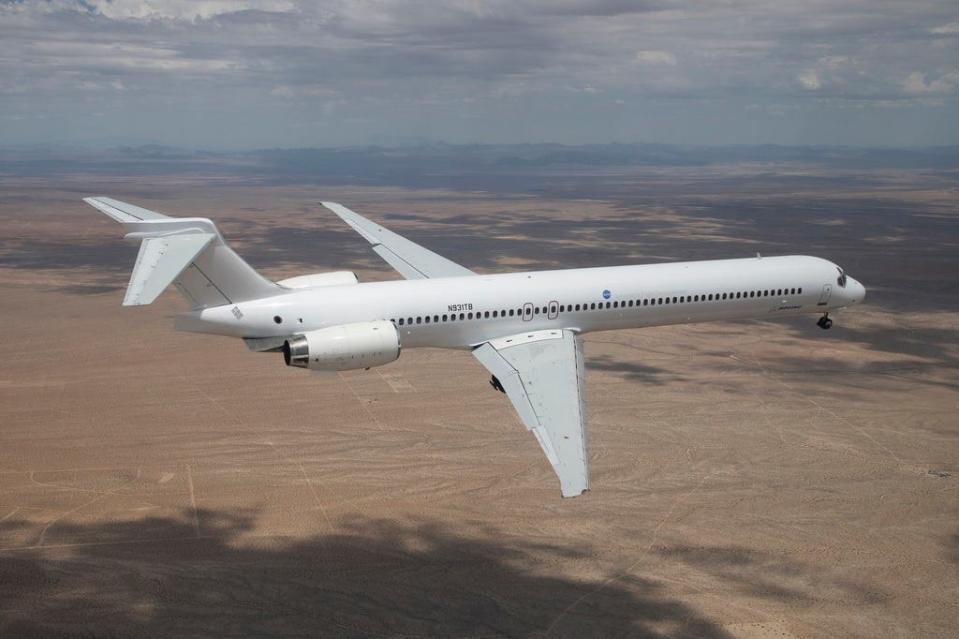Aircraft ferried from Victorville to Palmdale for experimental aircraft project
Boeing has partnered with NASA to ferry an MD-90 airplane from Victorville to Palmdale as part of an experimental aircraft project.
Boeing's MD-90 will undergo modifications to test the Transonic Truss-Braced Wing configuration as part of the development of the experimental X-66A aircraft, according to the aviation company
The MD-90 was housed at the Southern California Logistics Airport in Victorville.
Net-zero emissions goal
The X-66A is the focal point of NASA’s Sustainable Flight Demonstrator project, which aims to bring the aviation industry closer to its goal of achieving net-zero emissions by 2050.
We're on our way!
This MD-90 was ferried to Palmdale for conversion into the X-66A, the flying test article for the Sustainable Flight Demonstrator program.
This groundbreaking work could reduce fuel consumption and emissions up to 30%.
More: https://t.co/b3enw4roSD pic.twitter.com/7XY5xpmjno— The Boeing Company (@Boeing) August 17, 2023
At the United Nations Climate Change Conference in November 2021, U.S. Transportation Secretary Pete Buttigieg released the U.S. Aviation Climate Action Plan that sets out to achieve net-zero greenhouse gas emissions from the U.S. aviation sector by 2050, the Federal Aviation Administration reported.
With the MD-90 and X-66A project, the idea is to identify and mature “key airframe technologies – such as new wing designs – that have a high probability of transition to the next generation” of commercial narrow body aircraft, NASA said.
Boeing’s MD-90 aircraft flew from Victorville to Palmdale, on Aug. 15. Future modifications to the aircraft will include changes to the fuselage and most notably the use of a transonic truss-braced wing.
The brace wing is one of the advanced technologies that will be introduced onto the demonstrator, featuring ultrathin wings reinforced by struts with larger spans and higher aspect ratios.

In addition to the innovative wing design, NASA said additional technologies will be used “to help achieve fuel consumption and emissions reductions of up to 30 percent.”
Boeing and NASA have worked together on the TTB Wing concept for more than a decade through the Subsonic Ultra Green Aircraft Research (SUGAR) program. The pair will continue their partnership to produce the X-66A demonstrator aircraft.
"We at NASA are excited to be working with Boeing on the X-66A Sustainable Flight Demonstrator making critical contributions to accelerate aviation towards its 2050 net-zero greenhouse gas emission goal," said Ed Waggoner, deputy associate administrator for programs in the NASA Aeronautics Research Mission Directorate.
Victorville to Palmdale
The ferry flight of the MD-90 sustainable flight demonstrator marked a pivotal moment in the development of the experimental X-66A. Boeing celebrated the accomplishment at its Palmdale facility on Aug. 17, with a gathering attended by company executives, NASA representatives, and local community leaders.
“This marks an important step in the Sustainable Flight Demonstrator project, advances Boeing’s commitment to sustainability, and brings us closer to testing and validating the TTBW design,” said Boeing chief technology officer Todd Citron.
The event included the unveiling of photos capturing the MD-90 aircraft’s journey from Victorville to Palmdale, where it will undergo the TTBW modification process.
NASA and Boeing unveiled the new X-66A livery at EAA AirVenture Oshkosh 2023.
Rep. Mike Garcia (CA-27) applauded the Boeing-NASA initiative, highlighting the historical significance of Southern California — known as “America’s Aerospace Valley” — as an incubator of aerospace innovation.
“Aerospace Valley has a long and distinguished history as the cradle of aerospace innovation, and this unveiling [of the sustainable flight demonstrator] is a continuation of that critical work,” Garcia said. “Palmdale’s talented workforce and infrastructure make it the perfect location for this important project.”
The modifications to the MD-90 are anticipated to “begin soon,” according to Boeing, while ground and flight testing are slated to begin in 2028.
“Results of the flight tests will help inform industry decisions as to the design of new production single-aisle aircraft for the 2030s,” NASA stated.
Daily Press reporter Rene Ray De La Cruz may be reached at 760-951-6227 or RDeLaCruz@VVDailyPress.com. Follow him on Twitter @DP_ReneDeLaCruz
This article originally appeared on Victorville Daily Press: Victorville hosted airplane for experimental aircraft project

